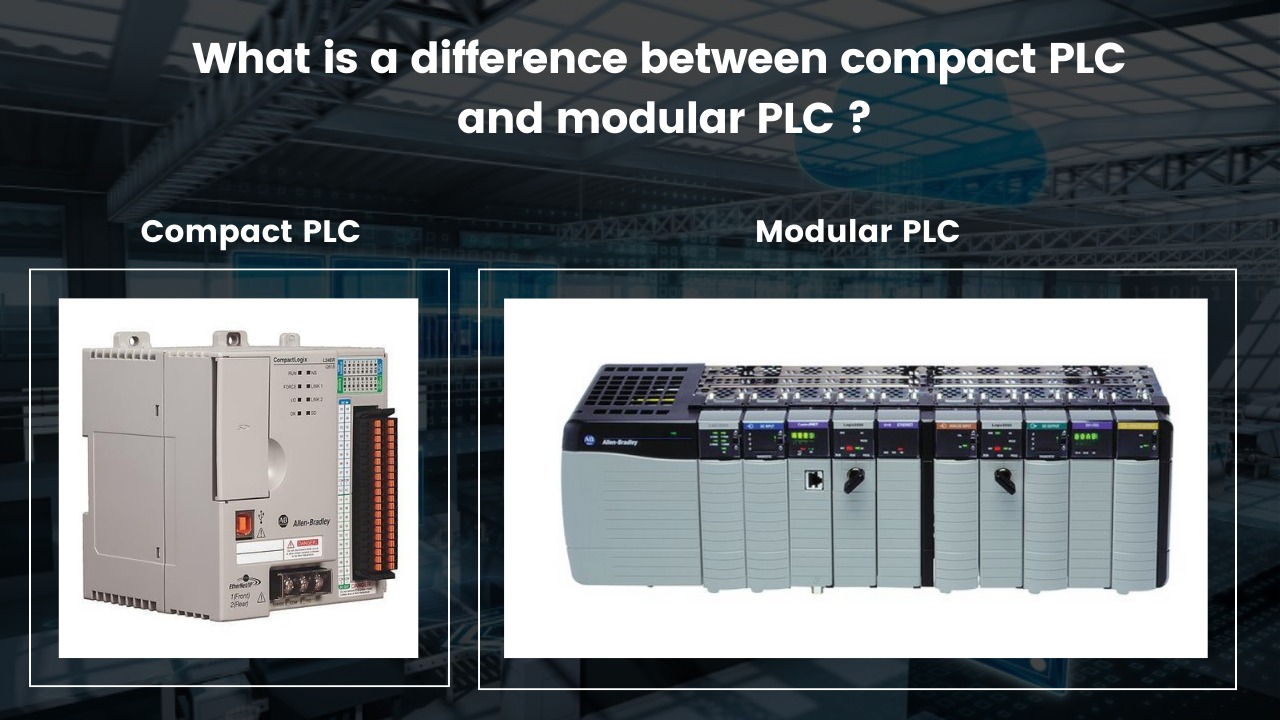Contents
Compact PLCs and modular PLCs are both types of programmable logic controllers used in industrial automation, but they differ in terms of size, flexibility, and expandability.
Compact PLC:
A freestanding device with a predetermined number of built-in inputs and outputs is referred to as a compact PLC, also known as a fixed PLC or brick PLC. It has a reduced form factor and is created as a single integrated unit. Compact PLCs are appropriate for applications that just need a few I/O points and have straightforward automation needs.
Advantages of Compact PLCs:
1. Space-saving:
Compact PLCs are appropriate for applications with restricted space because of their smaller physical footprint.
- Smaller Form Factor: Compact PLCs are built to be small and take up less room. They frequently consist of a single integrated device, therefore additional modules or expansion racks are not required.
- Mounting Options: Compact PLCs are often made to be mounted quickly on panels, DIN rails, or in control cabinets. Their lower size makes it possible to utilise space effectively and integrate them into current systems with ease.
Check: Rockwell Automation CompactLogix PLC
2. Simplicity:
Due to its integrated architecture and constrained I/O possibilities, they provide a simplified setup, programming, and maintenance process.
- Setup and Installation: Compact PLC setup procedures are frequently made simpler. They have user-friendly software, clear labelling, and intuitive user interfaces, which make configuring and installing the PLC simpler for users.
3. Cost-effective:
When compared to modular PLCs, compact PLCs are frequently more cheap, making them a sensible option for smaller-scale applications.
- Lower Initial Cost: Compact PLCs typically cost less up front than modular PLCs. They have a set number of built-in I/O points and are intended for smaller-scale applications. They are a more affordable solution, especially for projects with little automation requirements, due to their reduced starting cost.
4. Faster response:
Compact PLCs can frequently offer quicker response times for real-time control applications because of their small size and integrated design.
- Reduced Processing Time: Compact PLCs have fewer I/O points and are meant to tackle smaller-scale automation tasks. They have faster response times as a result of their technology and software being optimized for speedy processing and execution of control logic.
Modular PLC:
A modular architecture is used in the design of a modular PLC, making expansion and customization simple. It is made up of a base unit, sometimes known as a CPU module, and independent I/O modules, which can be added or deleted as needed. Applications requiring a high number of I/O points or future scalability and flexibility should use modular PLCs.
Advantages of Modular PLCs:
1. Flexibility and scalability:
When automation needs change, modular PLCs make it simple to add I/O points and functionality without having to replace the entire PLC.
- Increased I/O Capacity: The benefit of modular PLCs is that they may increase I/O capacity as needed. It is possible to expand the number of input and output modules, which will increase the number of devices and sensors that can be controlled.
Rockwell Automation MicroLogix 1400 PLC
2. Customizability:
According to their application requirements, users can choose and add particular I/O modules, optimizing system setup and reducing superfluous expenditures.
- Module Selection: Users of modular PLCs can choose and add particular modules in accordance with the needs of their applications. I/O modules of all kinds, communication modules, analogue modules, specialized modules, and more can be included in these modules. Users have the freedom to select the precise module combination that best meets their unique requirements.
3. Improved maintenance:
Because malfunctioning modules can be quickly replaced without impacting the overall system, the modular architecture makes troubleshooting and maintenance easier.
- Modular Design: The modular nature of modular PLCs makes maintenance and troubleshooting simple. The system is organized into various modules, each of which performs a certain purpose. Only the afflicted module needs to be replaced or repaired in the case of a failure or malfunction, minimizing downtime and lowering maintenance costs.
4. Cost-effective for larger projects:
As just the required modules need to be added, modular PLCs offer cost savings in the long term for applications that require extensive I/O or future expansion, while having a higher initial cost.
- Scalability: As a project’s requirements grow, modular PLC systems provide the option to build up the automation infrastructure. To meet the project’s expanding requirements, more I/O modules, communication modules, or specialty modules can be introduced. Cost savings occur from the elimination of the requirement to replace the complete PLC system due to its scalability.
- Selective Expansion: Not all areas or processes may need the same degree of automation in larger projects. You have the freedom to selectively increase and customise the automation in particular areas using modular PLC systems depending on their importance and needs. This focused strategy enables effective resource allocation and cost reduction.
Asteam Techno Solutions Pvt. Ltd. is the latest in the field of suppliers for automation parts and components. We mediate between the manufacturers and you, in order to facilitate your work. We trade with many manufacturers such as the most famous brands including Allen Bradley, Phoenix Contact, Moxa, Schneider Electrics, Omron, Siemens, Vipa and many more. We are ready to be the best and most qualitative provider of industrial spare parts. Do not hesitate to contact us – you simply send us an inquiry once the code of the part that you need.

